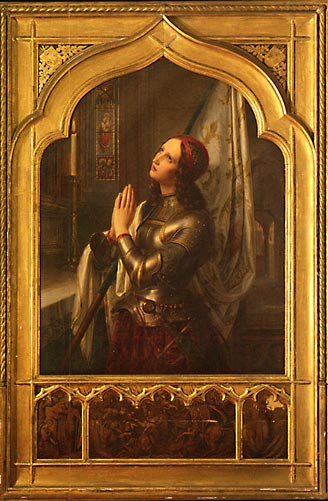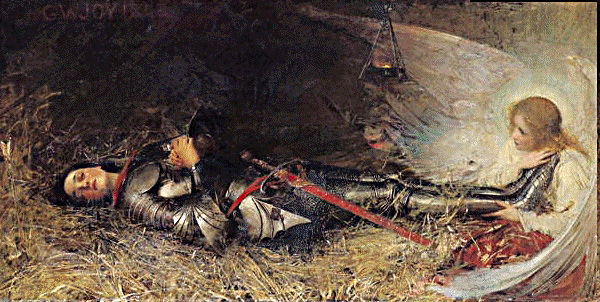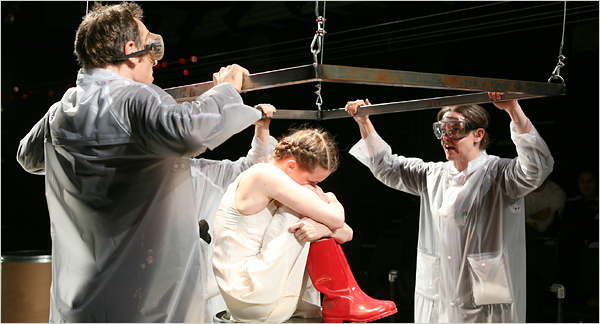The trial and execution of Joan of Arc was just the beginning for the poor soul. In the centuries since the Maid has continued to provoke anger and awe, becoming a symbol for monarchists, romantics, Left and Right…
Another movement which after 1815 contributed no less than did monarchism to the growing interest in the Maid of France was the romantic movement. There were many reasons why the romantics should have been interested in Joan of Arc. She was to them the child of nature, the daughter of the people. Believers in salvation theough scenery projected her against the background of her native fields and forests. It was in this light that she was seen by English romantics such as Southey, De Quincey and Landor, no less than by the great German romantic Schiller or a French romantic such as Alphonse de Lamartine. Michelet gave a romantic historians interpretation of Joan in some of the most celebrated pages of his Histoire de France. Verdi and Tchaikovsky presented Joan as she appeared to the romantic musician.

—Painting by Hermann Anton Stilke of Joan of Arc titled:
“Joan of Arc in Prayer”—Read More:http://www.maidofheaven.com/joanofarc_pictures4d.asp
A famous passage in Tchaikovsky’s opera gives us her farewell to her native woodlands, “Adieu, Forets;” in this, Tchaikovsky follows Schiller closely. Conservative opinion, after Chateaubriand, “took up” the romantic movement and gave it a Gothic turn; romantic pinters presented Joan against a Gothic background. Such sculptors as Dubois, Fremiet, and Anna Hyatt Huntington also exploited this theme; others, such as Chapu and Rude, continued the trtend of the earlier romanticism in presenting Joan as a peasant maid.
Many and complex are the uses of Joan as a symbol of French nationalism in the nineteenth century. French nationalists debated with the Germans over the possession of Joan, for some German writers claimed that since she had been born in Lorraine, then part of the Holy Roman Empire, she was not really French at all. Natives of Champagne and other French patriots maintained that she was really born in that province and that, therefore, as a “Champenoise,” she was indisputably French.

—Painting by George W. Joy in 1895 of Joan of Arc sleeping titled:
“Joan of Arc”
—Read More:http://www.maidofheaven.com/joanofarc_pictures3f.asp
It is easy to understand how Joan, as a Lorrainer, became after 1870 emblematic of those lost provinces, Alsace and in part Lorraine, which many Frenchmen wished to redeem from the national enemy. In her pride and in her suffering, Joan was the very symbol of a bruised and suffering but invincible France which “stared hypnotized at the gap in the Vosges.” The spirited monuments erected at this time in Nancy and even on the Ballon d’Alsace were symbols in this Irredentist sympathy.
In the eighties there begins an ardurous and pertinacious struggle, finally successful, to make the anniversary of Joan’s triumph a “fete nationale.” She continues in our own time to be a rallying point for French nationalism of all types. Andre Dahl’s novel Jeanne d’Arc Revint gives one of many ideas that see Joan as anti-imperialist and colonialist as she returns for the purpose of chasing Americans and Americanism from Paris…

—There are costly Manhattan kitchens that have not been designed with a quarter of the efficiency of Lear deBessonet’s production of “St. Joan of the Stockyards.” This infrequently seen Brecht play, now at Performance Space 122, imagines in this incarnation the fights between Christian principles and capitalism, labor and management, rich and poor as back-alley brawls from which there are no easy exits.
…
The stage, a narrow aisle that divides the audience in two, uses cables and pulleys, a wheeled gate and a gliding glass bungalow to suggest the stockyards, canneries and vulnerable management offices around which Brecht’s Marxist parable, set in the Chicago meatpacking industry of the 1920s, revolves. —Read More:http://theater2.nytimes.com/2007/06/23/theater/reviews/23stoc.html





 COMMENTS
COMMENTS